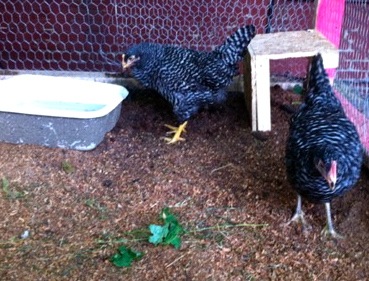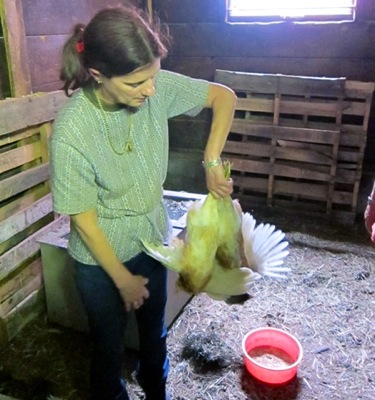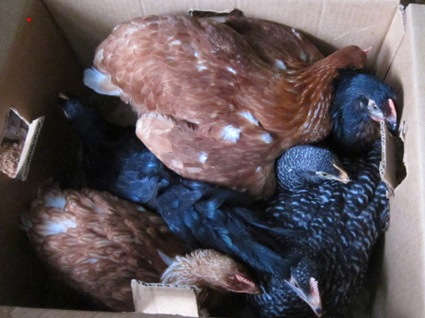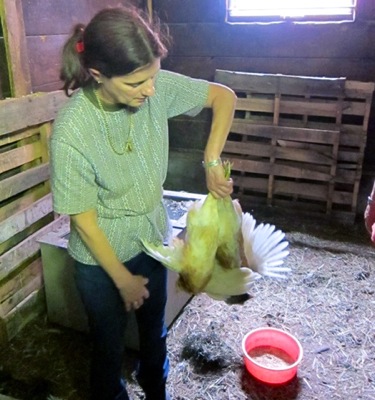 Barred Rock chickens.Photo: Nina LalliLast week, a friend called me for no reason — just to “say hi,” which I think is incredibly intrusive and even presumptuous. But I was feeling pret-ty good at that moment, and picked up. It went like this:
Barred Rock chickens.Photo: Nina LalliLast week, a friend called me for no reason — just to “say hi,” which I think is incredibly intrusive and even presumptuous. But I was feeling pret-ty good at that moment, and picked up. It went like this:
Friend: “What’re you doing?”
Secure · Tax deductible · Takes 45 SecondsSecure · Tax deductible · Takes 45 SecondsMe: “Just hangin’ out, drinking the kombucha I bartered some eggs for.”
Friend: “Jesus f***ing Christ. Don’t ever talk about that to me again.”
How did I arrive at this height of clichéd existence, living as a Brooklyn creative type with connections to kombucha brewers and a backyard chicken coop? Easy: It turns out you can just drive to a farm and buy some chickens. I highly recommend it.
After Tei (the boyfriend) and I struggled to not murder each other while constructing a chicken coop in the backyard of our apartment building, we started to look for nearby farms selling pullet hens. Pullets are like teenagers, still young but perfectly capable of laying eggs like so many other pitiable pre-pubescents. They don’t seem to suffer any of the self-loathing I personally remember from those days, nor the acne, nor the CERD (Compulsive Eye-Rolling Disease), but there are some biological similarities (more on that later).
 Doreen Weston, chicken wrangler extraordinaire. Photo: Nina LalliMany people who keep backyard hens start with newborn chicks, which cost only a few dollars each and are shipped through the mail (because the world is crazy). I’ve heard that the chicks can often arrive sick or dead and some have even been infected with salmonella. They are also several months away from laying eggs and extremely vulnerable.
Doreen Weston, chicken wrangler extraordinaire. Photo: Nina LalliMany people who keep backyard hens start with newborn chicks, which cost only a few dollars each and are shipped through the mail (because the world is crazy). I’ve heard that the chicks can often arrive sick or dead and some have even been infected with salmonella. They are also several months away from laying eggs and extremely vulnerable.
But the main reason we wanted to go to an actual farm to buy hens was a simple one: Tei and I like to know where our food comes from. And, when possible, we like it come from small farms. So it was an obvious excuse for a field trip.
Finding an actual farm turned out to be a little daunting at first. But when in doubt, go to Craigslist. But a friend who grew up on a farm and truly enjoys discussing the pros and cons of various chicken breeds was generous with advice and helped us vet the Craigslist ads we found. We ended up driving just an hour west of Brooklyn to Smoke Hollow Farm, in central New Jersey.
I showed up with the buzzy excitement I’ve always felt when adopting a new pet (which I’ve done way too many times to be normal). And it was nice to see that the farmer, Doreen Weston — while certainly no softy — sees her chickens, goats, sheep, and horses as pets, too. Her main business is actually training show horses; she started keeping chickens just for her own personal egg needs, but she got so much interest in pullet hens from others that she soon started breeding and selling them to neighbors with backyard dreams just like ours.
Doreen showed us the breeds she had: Rhode Island Reds (the common brown backyard hen), Barred Rocks (black-and-white speckled), and Black Stars (black) — all of which lay brown eggs. These three breeds possess two characteristics that are important to us: they’re considered “winter-hardy” (especially the Rholde Island Reds) and “good layers” (producing four or five eggs a week). Doreen was sold out of Araucanas, which lay the pale green eggs that inspired Martha Stewart’s paint collection (a fact I knew and felt compelled to share, and which was met with an immediate, straight-faced “good for her” from Farmer Doreen.) “They all taste the same,” she chuckled, managing (just barely) not to roll her eyes.
I admit it: I wanted the pretty eggs because they’re special and everyone would say “ooooh” when they saw them, but I got over it. It surprises me that the taste doesn’t vary much among breeds, but I later learned that egg taste is distinguished by various stages of richness rather than distinct flavors.
 The girls on the way home.Photo: Nina LalliTei and I had discussed buying three, maybe four chickens. But instead we bought six — two of each breed, for $12 each. When we showed Doreen an iPhone picture of our kooky chicken coop, she said we could probably keep a dozen. (The rule is that they really only need a wingspan’s worth of space each.) A flicker in Tei’s eyes seemed to say, After all that work on the facility, why not go for it? I could relate.
The girls on the way home.Photo: Nina LalliTei and I had discussed buying three, maybe four chickens. But instead we bought six — two of each breed, for $12 each. When we showed Doreen an iPhone picture of our kooky chicken coop, she said we could probably keep a dozen. (The rule is that they really only need a wingspan’s worth of space each.) A flicker in Tei’s eyes seemed to say, After all that work on the facility, why not go for it? I could relate.
Why not go for it? Because it would be an insane egg factory and we would have to buy most of the food they eat — that’s why. So we held back and stuck with six (which still produces too many eggs for two people to eat, by the way).
A silent man-farmer who worked with Doreen packed up the birds in a cardboard box with air vents, and we drove them home after Doreen assured us a few more times that chickens are easy to care for. They cooed, barely, all the way back — a little smooshed together but seemingly content.
When we got them home, we placed the box in the fenced-in run outside their coop and I opened it carefully. I stood back, expecting the birds to bust out and do crazy-bird stuff, but nothing happened. For a few minutes I assumed I’d killed them with road rage in the Holland tunnel. But the birds were just scared, like a gaggle of teenage wallflowers who just arrived at the dance. I dumped them out, upending the box completely, and they began to mill around slowly. And then, trend be damned, we were real urban farmers.




